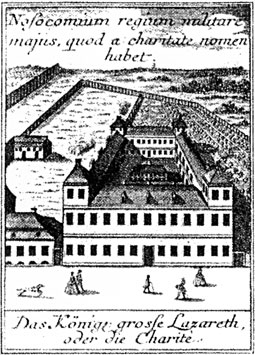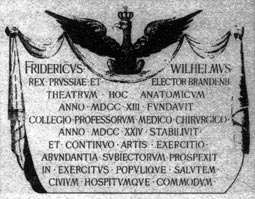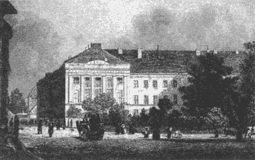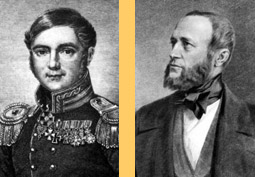


Part 1: The Great Age of Medicine in Berlin
by H. Behrbohm, W. Briedigkeit und G. Reintanz
Researchers and physicians such as Robert Koch (1843-1910), Emil Du Bois-Reymond (1818-1896), Paul Ehrlich (1854-1915) or Emil von Behring (1854-1917) were the outstanding personalities of this era who moulded the reputation of medicine in Berlin and that of the Charité hospital.
The pioneers of plastic surgery in the 19th century in Berlin were Carl Ferdinand von Graefe, Johann Friedrich Dieffenbach and Ernst von Bergmann. They developed important foundations of this special field in surgery and thus became the predecessors of Jacques Joseph and his work (see Part 2) in the first decades of the 20th century.

The Beginnings of the Charité Hospital:
A Hospital for the Poor and
a Training Hospital for Students
The history of the Charité hospital begins with the great Silesian plague epidemic in the year 1709. At that time Friedrich I, King of Prussia, decreed a Pestreglement (plague regulation), which was intended to counter the danger of plague by building a Plague Hostel outside of the town. In 1710, then, a Plague Hostel was duly erected on the outskirts of Berlin to isolate those struck down with the plague. The plague epidemic did not reach Berlin, however, and thus the building was changed into a hospital for the poor. ‘It shall be named the House of Charity (Charité in French)’, commanded King Friedrich Wilhelm I, the son of King Friedrich I, who ascended the throne of Prussia in 1713.
‘The Charité House, which is our largest such institution, has a triple purpose. It consists namely of 1) a hospital where ill and dying people shall receive food; 2) a training institute for the royal resident surgeions and others who study at the Collegio medico-chirurgico; and 3) a hospital and an institution in which poor pregnant women, married and unmarried, are taken in shortly before the birth of their children, are fed, taken care of at the birth of said children and not released until some weeks after’, wrote the chronichler of medicine in Berlin, Ludwig Formey, in the year 1796.
The Plague Hostel, built in 1709, was changed into a hospital and then named ‘Charité’.
Chr. W. Hufeland: ‘The Head Physician of the Charité’
and first Dean of the Faculty of Medicine
Christoph Wilhelm Hufeland (1762-1836) was dedicated to the principles of altruism and the Enlightenment, and is among the most popular figures of German medical history. In 1780 he began his studies of medicine in Jena, and he did his doctorate in Göttingen in 1783. Following this, he took over his father’s practice in Weimar, became acquainted with Goethe, among other people, and practiced as his personal physician. In 1800 he was called to Berlin and there became ‘The Head Physician of the Charité’ and Director of the Collegium medico-chirurgicum, which had already been founded in 1724. In 1799 he had already expressed the following opinion on the tasks of a clinic: ‘Es kommt hierbey alles auf die Bestimmung und den Zweck solcher Anstalten an, und dieser ist dreifach: Hülfe des ärmeren oder verlassenen Kranken – Vervollkommnung der Heilkunst durch genauere Beobachtung und unter Aufsicht angestellte Versuche – und Bildung der Wundärzte zum practischen Heilgeschäft’. (‘All depends upon the function and purpose of such an institution, and this is threefold: help for the poorer or abandoned sick, the perfection of the art of healing by more exact observation and experiments executed under supervision, and the training of surgeons to their practical business of healing.’)



Carl Ferdinand von Graefe:
The First Professor of the Clinical Surgical and
Ophthalmological Institute
Carl Ferdinand von Graefe (1787- 1840) began his education early and became ‘Doktor der Heilkunde und Wundarzneikunst’ (‘Doctor of Medicine and Surgery’) in 1807 in Leipzig. For some years he was personal physician to the Duke of Anhalt-Bernburg and Head of Medicine in this duchy; in 1810 he was called to the newly-founded University in Berlin as first Professor of the Clinical Surgical and Ophthalmogical Institute by Wilhelm von Humboldt, at the age of only 23. He was a talented surgeon. One of his pupils, L. Stromeyer, later wrote about him: ‘... Sein Vortrag war klar und verständlich, seine operative Geschicklichkeit eminent. Er besaß den Willen und die Fähigkeit ein guter Lehrer zu sein. Ich habe in den beiden Semestern, in welchen ich seine Klinik besucht, nichts von ihm gesehen, was er nicht vor Gott und den Menschen hätte rechtfertigen können. Er suchte die Diagnose soviel als möglich fest-zustellen, ehe er operierte, und wandte alles an, um den Erfolg sicherzustellen. Er war in allem exakt ...’
The Charité Hospital in 1833

Johann Friedrich Dieffenbach: ‘...remakes the nose and the ears’
Johann Friedrich Dieffenbach (1792-1847), born in Königsberg, began the study of theology in 1812, after finishing school. In 1816, however, he decided to study medicine – influenced by the occurrences in the war of 1813/1814, in which he had volunteered – and registered at the University in Königsberg. In 1820 he left Königsberg and continued his studies in Bonn, Paris and Montpellier. In 1822 in Würzburg he obtained his doctorate in medicine with a dissertation with the title ‘Nonnulla de transplantatione et de regeneratione’. In the following year he settled in Berlin and founded a practice there. In 1829 Dieffenbach was made ‘Directing Physician’ of the Surgical Department at the Charité hospital; three years later he was named Professor extraordinary (meaning the chair was not a regular one). In the summer of 1840 C. F. v. Graefe died, whereupon Dieffenbach succeeded him. Having had his enthusiasm for facial plastic surgery awakened by Graefe, Dieffenbach busied himself with the further development of plastic operations. He was a pioneer in the surgery of the lips, jaw and cleft palates, as well as blepharoplasty; he studied tenotomy in cases of clubfootedness and the operations upon squints with equal intensity.
He furthered the practice of rhinoplasty by developing a method using a double flap, which could replace both skin and mucous membrane defects, thus helping to prevent severe flap shrinkage. He became internationally known through his first strabotomy and numerous monographs. Besides Guillaume Dupuytren in France, Ashley Cooper in Great Britain and Nikolai Pirogow in Russia, he counted among the greatest surgeons of his time and is regarded as the founder of plastic surgery.
Dieffenbach’s special reputation in the Berlin of the 19th century is documented by this episode: at the society balls of 1831/32 a young, particularly attractive girl caused quite a stir, because she always hid her face behind a gold mask. The secret of Elvira Tondeau was a face which caused fear and disgust, deformed by an ulcerous destruction of the nose, probably the result of a tuberculosis cutis luposa. Dieffenbach succeeded in reconstructing her nose in the course of several sessions. One year later Elvira was affianced in full view of the public. Popular imagination was fired by this and composed the following ditty:
‘Wer kennt nicht Doktor Dieffenbach
den Doktor der Doktoren,
er schneidet Arm’ und Beine ab,
macht neue Nas’ und Ohren’.
(Who doesn’t know Doctor Dieffenbach,
the doctor of doctors,
he cuts off arms and legs
and makes a new nose and ears.
Somewhat more elegantly, but less literally:
Who hasn’t heard of Doc Dieffenbach,
The doctor who nothing fears,
He chops off arms and legs
And makes a nose and ears.)
Dieffenbach’s successor in the Charité hospital in 1848 was Bernhard von Langenbeck (1810-1887), who was also an experienced plastic surgeon.

General Anaethetics and Asepsis
Bring Progress in Surgery
In the year 1846 the development of general anaesthetics commences, which enabled painless operating henceforth. In 1847 J. F. Dieffenbach’s book was published, ‘Der Äther gegen den Schmerz’ (Ether Against Pain). Dieffenbach was most enthusiastic about the possibility of painless surgery: ‘Der wunderbare Traum, daß der Schmerz von uns genommen würde, ist Wirklichkeit geworden. Schmerz, die höchste Bewußtheit irdischer Existenz, die klarste Wahrnehmung der Unvollkommenheit unseres Körpers, muß sich vor der Macht des menschlichen Geistes beugen, vor der Macht des Äther-Dampfes.’ (‘The wonderful dream of pain being taken from us has become reality. Pain, the highest level of consciousness in our earthly existence, the clearest perception of the imperfect state of our body, has had to give way to the might of the human mind, the might of the aetheric vapour.’)
Ernst von Bergmann (1836-1907)
Ernst von Bergmann: introduced Asepsis in surgery
Ernst von Bergmann (1836 - 1907), who came from Riga, studied medicine in Dorpat, now in Estonia, and was active thereafter in Dorpat and in Würzburg. In 1882 he was called to be the successor of the retired Bernhard von Langenbeck on the Chair for Surgery and Head of the Surgical Department at the Charité hospital. Bergmann – one of the most important surgeons of his time – introduced the principle of asepsis in surgery. He demanded that everything having any contact with the area of the operation – particularly with the wound – must be totally and completely germ-free. E. v. Bergmann remained active at the Charité hospital until his death in 1907. His successor was August Bier (1861-1949).
To be continued with Part 2: ‘Jacques Joseph and His Activities in Berlin’.Literature with the author.
Correspondence address:
Prof. Dr. med. H. Behrbohm
Abt. für HNO-Heilkunde,
plastische Operationen
Park-Klinik Weissensee
Schönstraße 80, 13086 Berlin